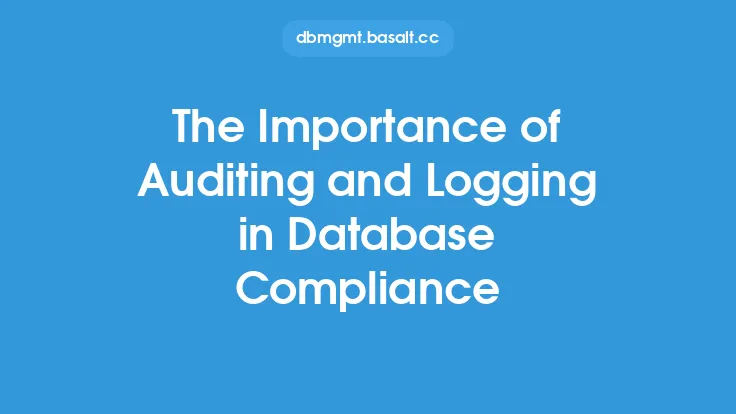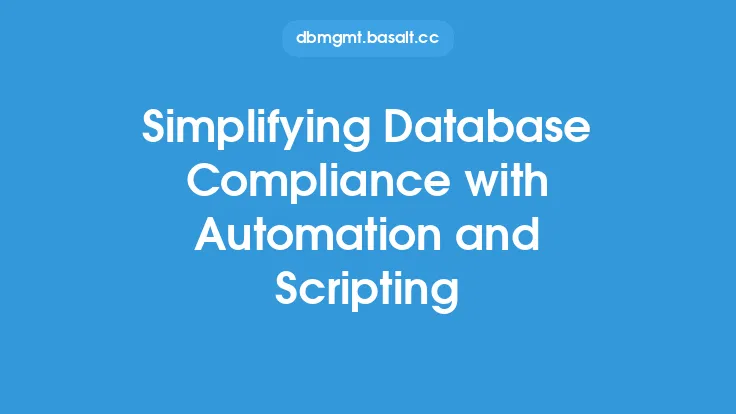As databases continue to play a critical role in storing and managing sensitive information, the importance of staying ahead of compliance risks cannot be overstated. One key aspect of achieving this goal is through effective database monitoring and alerting. In today's complex and ever-evolving regulatory landscape, organizations must be proactive in identifying and mitigating potential compliance risks. This involves implementing a robust monitoring and alerting system that can detect and respond to security threats, data breaches, and other compliance-related issues in real-time.
Introduction to Database Monitoring
Database monitoring is the process of tracking and analyzing database performance, security, and activity in real-time. This involves collecting and analyzing data on database transactions, user activity, system performance, and other key metrics. Effective database monitoring provides organizations with the visibility and insights needed to identify potential compliance risks, detect security threats, and optimize database performance. By monitoring database activity, organizations can quickly identify and respond to potential compliance issues, reducing the risk of data breaches, fines, and reputational damage.
The Importance of Alerting in Compliance
Alerting is a critical component of database monitoring, as it enables organizations to respond quickly and effectively to potential compliance risks. Alerting involves setting up automated notifications that are triggered when specific conditions or thresholds are met. For example, an alert may be triggered when a user attempts to access sensitive data without proper authorization, or when a database transaction exceeds a certain threshold. By setting up alerts, organizations can ensure that potential compliance issues are addressed promptly, reducing the risk of non-compliance and associated penalties.
Types of Database Monitoring and Alerting
There are several types of database monitoring and alerting that organizations can implement, depending on their specific needs and requirements. These include:
- Performance monitoring: This involves tracking database performance metrics such as query execution time, CPU usage, and memory usage.
- Security monitoring: This involves tracking database security metrics such as user activity, access attempts, and data encryption.
- Audit logging: This involves tracking and analyzing database transactions, including changes to data, schema, and permissions.
- Anomaly detection: This involves using machine learning and other advanced analytics techniques to identify unusual patterns of activity that may indicate a compliance risk.
Implementing Effective Database Monitoring and Alerting
Implementing effective database monitoring and alerting requires a combination of technology, processes, and people. Organizations should start by identifying their specific compliance requirements and risks, and then selecting a monitoring and alerting solution that meets their needs. This may involve implementing a commercial database monitoring tool, or developing a custom solution using open-source technologies. Organizations should also establish clear processes and procedures for responding to alerts and addressing potential compliance issues. This may involve setting up an incident response team, establishing communication protocols, and defining escalation procedures.
Best Practices for Database Monitoring and Alerting
There are several best practices that organizations can follow to ensure effective database monitoring and alerting. These include:
- Implementing real-time monitoring and alerting: This enables organizations to respond quickly and effectively to potential compliance risks.
- Setting up customized alerts: This enables organizations to tailor their alerting system to their specific needs and requirements.
- Establishing clear incident response procedures: This ensures that organizations can respond quickly and effectively to potential compliance issues.
- Providing ongoing training and support: This ensures that database administrators and other stakeholders have the skills and knowledge needed to effectively use the monitoring and alerting system.
- Continuously reviewing and refining the monitoring and alerting system: This ensures that the system remains effective and aligned with changing compliance requirements and risks.
Technical Considerations for Database Monitoring and Alerting
From a technical perspective, database monitoring and alerting involves collecting and analyzing data from a variety of sources, including database logs, system metrics, and user activity. This may involve using APIs, scripts, and other tools to collect and integrate data from different sources. Organizations should also consider implementing data encryption, access controls, and other security measures to protect sensitive data and prevent unauthorized access. Additionally, organizations should ensure that their monitoring and alerting system is scalable, reliable, and performant, and can handle large volumes of data and traffic.
Conclusion
In conclusion, database monitoring and alerting are critical components of a comprehensive compliance strategy. By implementing effective monitoring and alerting, organizations can stay ahead of compliance risks, detect security threats, and optimize database performance. By following best practices, implementing effective technology, and establishing clear processes and procedures, organizations can ensure that their database monitoring and alerting system is effective, efficient, and aligned with their specific needs and requirements. As the regulatory landscape continues to evolve, organizations must remain proactive and vigilant in their compliance efforts, and database monitoring and alerting will play an increasingly important role in achieving this goal.





